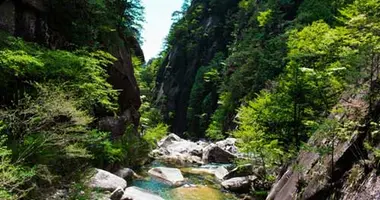Nagatacho
Tokyo Area Guide: Nagatacho 永田町

Japanese Diet Building, Nagatacho, Tokyo
Nagatacho is what Capitol Hill is to the States, or Westminster is to London, and, like those centers of power, the placename alone signifies "national politics" - as opposed to the bureaucracy, which is concentrated in nearby Kasumigaseki.
This area of Tokyo's Chiyoda ward, only a few hundred meters from the Imperial Palace, is home to the National Diet Building, the Office of the Prime Minister, and the Cabinet Office (内閣府; naikakufu).
The National Diet Building is an imposing pyramid-roofed structure built between 1920 and 1936. The north wing houses the House of Councillors (with 242 members), and the south wing, the House of Representatives (with 480 members).
A free 60-minute tour of the Upper House of the National Diet (the House of Councillors, or Sangiin in Japanese) is available between 8 am and 5 pm on weekdays (last entry 4 pm). Go to the House of Councillors website for details.
The imposing, modern Office of the Prime Minister, or Kantei, is diagonally opposite the National Diet Building, and was completed in 2002, replacing the previous one built in 1929. It is accessible from Tameike-sanno Station on the Chiyoda, Marunouchi, and Nanboku Subway Lines.

Cabinet Office, Nagatacho, Tokyo

The Kensei Kinenkan is dedicated to Japanese democracy and the life of Yukio Ozaki, known as the "God of constitutional politics" and the "father of the Japanese Constitution", Nagatacho, Tokyo
The National Diet Library is just north of the National Diet Building. It dates from 1948. As well as its legislative collection, it also keeps maps, foreign books about Japan, and even all phonographic recordings made in Japan. Tours of the Library are available. Go to the National Diet Library website for details.
The massive Hie Shrine (hee-eh) is also located in Nagatacho. Hie Shrine is a centuries old Shinto shrine dedicated to Ohyamakui-no-kami, the guardian deity of Edo Castle, which was on the site now occupied by the present Imperial Palace. Destroyed in the Pacific War, Hie Shrine's present structure dates from 1958. It features the Sanno Matsuri festival - an early-to-mid June festival, and one of the big three festivals of old Edo (i.e. pre-1868 Tokyo).
The Kensei Kinenkan (Parliamentary Museum) is dedicated to Japanese democracy and the life of Yukio Ozaki, known as the "God of constitutional politics" and the "father of the Japanese Constitution." The free museum has exhibits and original photographs explaining the history of Japanese democracy. There is a replica chamber of the House of Representatives, interesting movies and the Ozaki Memorial Hall.
Also in this area of Tokyo is the imposing Supreme Court Building and the National Theater (国立劇場; Kokuritsu Gekijō).
The five story Supreme Court (最高裁判所; Saiko-Saibansho) in its present location dates from 1974. It was designed by Japanese architect Okada Shinichi. The court maintains judicial authority to interpret what is and what is not constitutional under the Japanese constitution. It decides questions of national and local law and has the power of judicial review.
There are several National Theatre buildings throughout Japan. These include the National Engei Hall (part of the National Theatre complex close to Hanzomon Station), the National Noh Theatre in Shibuya, the National Bunraku Theatre in Osaka, the National Theatre Okinawa in Urasoe and the New National Theatre, Tokyo, also in Shibuya.
The grounds around the Diet Building contain over 1600 cherry tres and also around 170 flowering dogwoods, presented by the government of the United States.
Interestingly, the Standard Benchmark of Japan is located here. It was established in 1891 and it is the benchmark from which all elevations in Japan are measured.

Replica chamber of the House of Representatives, Kensei Kinenkan, Nagatacho, Tokyo

Supreme Court Building, Nagatacho, Tokyo
Hotels near Nagatacho
Nagatacho and environs has several quality hotels.
The top of the range Hotel New Otani Tokyo the Main (in nearby Kioicho), the Akasaka Excel Hotel Tokyu, the 91-room Hotel Sunroute Akasaka, the Akasaka Granville Hotel, the Toshi Center Hotel (in nearby Hirakawacho), Le Port Kojimachi (also in Hirakawacho), the APA Villa Hotel and the venerable Capitol Tokyu Hotel, the flagship hotel of the Tokyu hotel chain.

National Diet Building, Tokyo

Nagatacho Subway Station with US & Japan flags honoring President Barack Obama's visit in 2014, Tokyo
Getting to Nagatacho
The northern part of Nagatacho is served by Nagatacho station on the Namboku Line (station no. N-07), the Yurakucho Line (Y-16) and the Hanzomon Line (Z-04), and, a little westward, Akasaka-mitsuke Station on the Ginza Line (G-05) and Marunouchi Line (M-13). Nagatacho Station and Akasaka-mitsuke Station are connected by an underground walkway.
The southern part of Nagatacho is served by Tameike-Sanno station on the Ginza Line (G-06) and Namboku Line (N-06), and Kokkai-gijidomae station on the Chiyoda Line (C-07) and the Marunouchi Line (M-14). These two stations are very close together and connected by a walkway.
For a full listing of Tokyo Museums & Art Galleries click here

The National Theatre built in the azekura-zukuri style of the Nara Period
Nagatacho Tokyo. Read a guide to the center of Japan's political system and the seat of the Japanese government -Nagatacho in Tokyo.






























